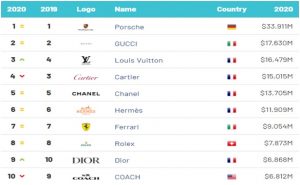By: Bushra Sarwar
What is a luxury brand?
The brand is the identity of a product which get associated with the customer. Branding is like the positioning of the product in the mind of the consumer. As per marketing management professor, Kotler, brands are designed by companies in such a way so that consumer can relate it or get associated with it.
As per the Economic theory, luxury brands are those brands whose demands increase with the rise in income of the consumer. Luxury brands are in contrast to the necessity of goods. So, the need of luxury brand is proportionally related to payment of the consumer. They are mostly status symbol products and catered to classy people. Luxury brands are targeted to high-class income group people.
Sometimes, luxury brands are equal to superior products. The essence of luxury goods is that they have high demand elasticity of sales, which suggests that they can profusely partake in the buying of luxury goods as individuals become bounteous & wealthier. However, this also means that if there is a reduction in consumer income, then demand will also decrease.
First and foremost, a brand-driven industry is the luxury industry. People purchase luxury products and services because they trust the brand and love it. Premium products and services are guided by their brand perception and success rather than any other group.
Learn more about Marketing Management Foundations with Enhelion’s Online course certified by Sahil Malhotra!
How companies build luxury brands:
How do businesses build profitable brands? How do they make those products resonate through time and space with customers? What are the main success factors that cause the global brand environment to be dominated by some brands? These questions come into the mind of the CEO of the company and brand manager all around the world. Develop a brand is not a one day or one-time affair. It is a long-term process to develop the image of a product in the mind of consumers. The company needs specific marketing and branding plan to increase brand outreach.

Source: Author’s Creation
Figure 1 Process of building Luxury Brands
Figure 1 presents the process of creating luxury brands. Identification of niche segment is the most critical steps in the process of building brands. For different products, the company should adopt different differentiation strategies. Develop the symbol for creating value in the brands. The brand creates exclusivity feature to make a difference among other brands. These all part together position the image of the brand in the mind of the customer. The above component will help brand managers to create luxury brands.
List of top 10 popular luxury brands

Source: branddirectory.com
What are marketing strategies?
The long-term preparation of corporate targets that the organisation aims to accomplish is a Marketing Strategy/Technique. It is necessary to choose specific measures to consolidate the credibility of goods and services or increase market sales to achieve these objectives. To identify the target market and to be able to keep customers loyal to the organisation to improve the positioning of the company, it is necessary to use opportunities.
To achieve positioning among customers and satisfy consumer and organisational relationship loyalty, it is essential to identify how do you want to place or position the product/service in the market. It is the method of creating sales opportunities, also of communicating and setting the product or service, and of translating the organisational lines that allow the correct channels to reach a target market.
Why does Company need marketing strategies?

Figure 3 Why company needs marketing strategies?
Source: Author’ created
Learn more about Marketing Management Foundations with Enhelion’s Online course certified by Sahil Malhotra!
Marketing strategies adopted by luxury brands:
As per 2014 Mckinsey report, digital platform influences the 45% sale of luxury products. Luxury brands prefer to do advertising through print and electronic media. Nowadays, shoppers spent most of its time on online shopping, so luxury brands are coming on a digital platform to promote their products. Taylor (2020) suggested digital marketing strategies for luxury brands:

Analysis of marketing strategies
Michael porter defined four kind of generic strategies to create competitive advantage.
- Cost leadership
- Cost focus
- Differentiation Leadership
- Differentiation Focus
The Cost Leadership Approach focuses on minimising the cost of providing a customer’s goods or services, to become cost-efficient and add value to your shareholder’s wealth.
Under differentiation strategy, instead of focusing on the most part, brands differentiated their products from competitors. Under which business houses differentiate their products in terms of design, comfort, quality, and value-added features. As per Oh and Kim (2011), most brands prefer to use differentiation marketing strategy to create a difference in the market. Oh, et al., (2011) conducted this study in Asian countries (Japan, China and South Korea) and chose Louise Vuitton brand to study marketing strategies. The author found three critical factors which create Louise Vuitton as a brand: innovation, differentiation and customer-centric advertising.
Cost focus strategy focuses on cost leadership to focus on a niche market. Cost leadership strategy does not work on luxury products. Any strategy based on low costing would not work in fashion brands. Differentiation focus is the part of the differentiation strategy, which is used by the luxury brands.
PEST and SWOT Analysis:
- PEST stands for political, economical, social and technological factor analysis.
- SWOT stands for strength, weakness, opportunity and threat analysis.
SWOT & PEST tests are two approaches through which businesses plan ahead by carrying out research. Such variables are primary determinants of strategic planning. Businesses may fail to achieve desired objectives without SWOT and PEST analysis.
Learn more about Marketing Management Foundations with Enhelion’s Online course certified by Sahil Malhotra!
Marketing strategies of famous brands:
Apple’s Brand:
Apple follows a straightforward brand strategy. As their tagline says: Think different, Apple think differently at every stage of the product (product preparation to launching). Apple does not merely sell a phone or tablet; they simply sell a lifestyle to its luxury customers. Apple’s brand marketing makes people realize that they need an apple product to enrich their life with quality products and profitable experience.
Nike’s Brand:
Nike creates a strategy by knitting the story of a brand. Nike takes this opportunity to make a possible story around its every product to start the ideas, which fascinate the customers.
Adding a storytelling element to your brand or presenting the meaning of your business storey to your customers adds a human element to your organisation and can be a perfect marketing strategy for you.
McDonald Brand:
McDonald is not a new name in the market; it is recognized worldwide. Marketing strategy of McDonald is to maintain consistency.
How did McDonald’s build a name so distinguishable? Well, for over 60 years, they have kept their brand name and product consistent while making thoughtful and on-brand enhancements. Their logo has remained nearly identical, and their marketing taglines have relentlessly endorsed the same message: we make you happy.
Conclusion:
This write-up talks about the analysis of the marketing strategies of luxury brands. The article starts with the introduction of luxury brands and how companies are creating luxury brands by adopting differentiation strategies and top 10 brands based on brand value globally. It also provides an understanding of marketing strategies and why luxury brands needed marketing strategies and what marketing strategies followed by brands.
This article also analysed the Michael porter competitive advantage strategies and found the luxurious brands follow differentiation strategy. PEST and SWOT analysis are the two essential techniques followed by companies to achieve desired objectives. Finally write up concluded by comparing the marketing strategies followed by famous brands: Apple, Nike and McDonalds.
Learn more about Marketing Management Foundations with Enhelion’s Online course certified by Sahil Malhotra!
References:
Top 50 luxury brands 2020. Retrieved by https://brandirectory.com/rankings/luxury-and-premium/table
https://www.toolshero.com/marketing/marketing-strategy/
How to build luxury brands. https://martinroll.com/resources/articles/strategy/five-steps-to-build-a-luxury-brand/
Oh, S., & Kim, J. (2011). Analysis of the Marketing Strategy of a Luxury Brand and its Success in Selected Asian Countries. International Journal of Interdisciplinary Social Sciences, 6(1).
Taylor, M. (2020). 10 Marketing Strategies For Luxury Brands That Deliver Results. Retrieved from https://www.ventureharbour.com/luxury-brand-digital-marketing/





